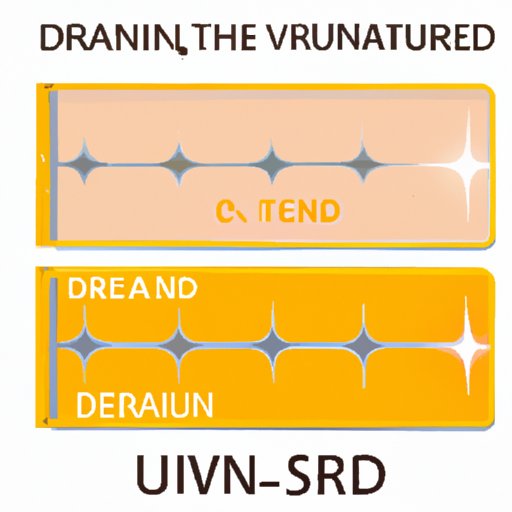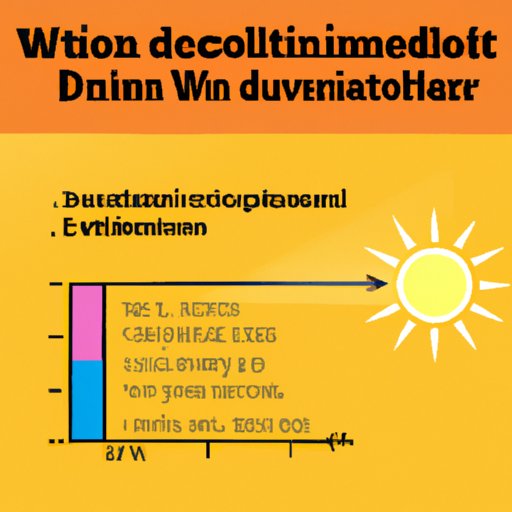
Introduction
Vitamin D, also known as the “sunshine vitamin,” is an essential nutrient that plays a vital role in our overall health. It helps maintain strong bones, boosts our immune system, and promotes healthy brain function. However, vitamin D deficiency is a common issue, especially for those living in areas with limited sunlight. To address this problem, some people turn to tanning beds to supplement their vitamin D levels. But is this an effective and safe solution? In this article, we explore the benefits and risks of using tanning beds for vitamin D production, alternative sources of vitamin D, the science behind vitamin D production in tanning beds, and the myths and misconceptions surrounding this controversial topic.

The Benefits and Risks of Using Tanning Beds for Vitamin D
Health Benefits of Vitamin D
Vitamin D is essential for our bodies to function optimally. It aids in calcium absorption and helps maintain strong bones, making it especially important for children and the elderly. It also plays a critical role in our immune system’s health, reducing inflammation and promoting a healthy immune response. Studies have also linked vitamin D to a reduced risk of certain cancers, heart disease, and neurological disorders like depression and Alzheimer’s disease.
The Risks Associated with Tanning Beds
Despite the potential benefits, using tanning beds to supplement vitamin D levels comes with risks. Tanning beds emit harmful ultraviolet (UV) radiation, which can cause skin damage, premature aging, and an increased risk of skin cancer. The more exposure to UV radiation, the higher the risk of skin damage and cancer. Alarming rates of skin cancer have been linked to tanning bed use, making it a serious concern.
1. Skin Damage and Cancer
UV radiation causes DNA damage and can result in skin cancer, including deadly forms like melanoma. The risk of developing melanoma increases by 75% when tanning bed use begins before the age of 35. Additionally, tanning beds can cause premature aging, sunspots, and other unsightly skin damage.
2. Eye Damage
UV radiation can also damage your eyes. Tanning bed use can increase the risk of certain eye conditions, including cataracts and macular degeneration.
The Pros and Cons of Using Tanning Beds for Vitamin D
While tanning beds can be a potential source of vitamin D, the risks associated with frequent tanning bed use outweigh the benefits. The American Academy of Dermatology recommends obtaining vitamin D from other sources, such as our diet, supplements, and natural sunlight.
Alternative Ways to Get Vitamin D without the Use of Tanning Beds
Diet
The easiest and safest way to get vitamin D is through a healthy diet that includes foods rich in vitamin D, such as fatty fish, eggs, fortified milk and cereal, and mushrooms. These foods can provide sufficient vitamin D for many individuals and avoid the risks associated with tanning bed use.
Supplements
Supplements can also be an effective way to boost vitamin D levels, especially for people who struggle to meet their dietary needs. It’s essential to check with a healthcare provider before taking any supplements to avoid any negative interactions or overconsumption.
Natural Sunlight
Safe exposure to sunlight remains one of the most significant ways to produce vitamin D naturally. The National Institutes of Health recommends getting 10-30 minutes of sunlight exposure two to three times a week, depending on skin pigmentation, time of day, and location. It’s essential to balance time in the sun with wearing protective clothing, such as hats and sunscreen with an SPF of 30 or higher, and avoiding peak UV hours from 10 AM to 4 PM.
The Science Behind Vitamin D Production in Tanning Beds
UVB Radiation and the Production of Vitamin D
Tanning beds emit UVB radiation, which is the same type of radiation responsible for natural sun-induced vitamin D production. When exposed to UVB radiation, our skin converts specific forms of cholesterol into vitamin D.
Types of UV Radiation in Tanning Beds
While tanning beds do emit UVB radiation, they also emit UVA radiation, a type of radiation that penetrates deeper into the skin and can cause skin damage and aging. This is one reason why the risks associated with frequent tanning bed use outweigh the benefits.
The Role of Melanin in Vitamin D Production
Melanin, the pigment that gives our skin its color, acts as a natural sunscreen, protecting the skin from UV radiation. As a result, people with darker skin pigmentation may require more extended exposure to UV radiation to produce the same amount of vitamin D as someone with fair skin pigmentation.
The Dangers of Overexposure to UV Light in Tanning Beds for Vitamin D Production
The Risks of Overexposure to UV Radiation
Excessive exposure to UV radiation can cause short-term and long-term effects, including sunburn, skin aging, and an increased risk of skin cancer. Regular use of tanning beds can damage the skin’s DNA and increase the risk of malignant melanoma, the deadliest form of skin cancer. Tanning bed users also have an increased risk of developing basal cell carcinoma and squamous cell carcinoma.
The Recommended Exposure Time for Vitamin D Production
Some people may think that using a tanning bed only for a few minutes daily would provide them with sufficient amounts of vitamin D. However, the ideal duration of exposure for vitamin D production varies based on several factors, such as skin tone, location, and time of day. Generally, just a few minutes of natural sunlight exposure can provide enough vitamin D.
How to Minimize the Risks of Tanning Bed Use
If you choose to use a tanning bed, it’s essential to minimize your risks. Use a reputable tanning salon, and always wear protective eyewear. Limit your exposure time, and be sure to avoid sunburns. Avoid tanning before the age of 18, and regularly check your skin for any concerning changes.
Comparing the Effectiveness of Vitamin D Production from Natural Sunlight and Tanning Beds
The Differences Between Natural Sunlight and Tanning Beds
Natural sunlight is a safer source of vitamin D than tanning beds because it contains both UVB and UVA radiation. UVA radiation can cause long-term skin damage and aging, making natural sunlight a more balanced source of UV radiation.
How to Calculate Vitamin D Production
The amount of vitamin D produced from UVB radiation varies depending on several factors, including skin pigmentation, age, time of day, and season. It can be challenging to calculate how much vitamin D a person produces from sunlight or a tanning bed. It’s best to consult with a healthcare provider to determine if vitamin D supplements are needed.
The Importance of Balance
Getting enough vitamin D is essential, but it’s equally vital to balance the risks associated with UV exposure. Tanning beds are generally not a safe way to raise vitamin D levels, and their risks outweigh the benefit. Individuals should be cautious about their sun exposure and choose safer methods, like diet and supplements, to obtain adequate vitamin D levels.
Tanning Beds and Vitamin D: Separating Fact from Fiction
Debunking Common Myths and Misconceptions
Many misconceptions surround the topic of tanning beds and vitamin D. One of the most common is the belief that tanning beds are safer than natural sunlight. This is simply not true; tanning beds emit high levels of UV radiation that can permanently damage the skin and increase the risk of developing skin cancer.
The Truth About Tanning Beds and Vitamin D Production
Tanning beds do produce vitamin D in the same way that natural sunlight does, but the risks associated with using a tanning bed outweigh the potential benefits. Supplements, diet, and natural sunlight are all safer options to obtain adequate vitamin D levels without the risk of skin cancer and other adverse health effects commonly associated with tanning bed use.
Final Thoughts
Vitamin D is a vital nutrient for our health, and adequate levels are essential for optimal health. While tanning beds may provide an attractive solution to those living in areas with limited sunlight, their risks outweigh their potential benefits. Alternative sources of vitamin D, such as diet, supplements, and natural sunlight, are safer ways to obtain this essential nutrient.
Conclusion
Recap of Key Points
In conclusion, tanning beds may produce vitamin D, but the risks associated with their frequent use outweigh the benefits. Alternative sources of vitamin D, such as diet, supplements, and natural sunlight, are safer options. It’s crucial to weigh the risks of UV exposure and choose a balanced, sensible approach to maintain adequate vitamin D levels.
Final Thoughts
We hope this article helps you make informed choices about your vitamin D needs. Remember to consult with your healthcare provider before making any significant changes to your diet, supplement use, or sun exposure.
Call to Action
If you’re concerned about your vitamin D levels, talk to your healthcare provider about the best ways to optimize your vitamin D intake safely. Don’t choose tanning beds to supplement your vitamin D levels. Instead, choose safer alternatives and support your overall health and wellness.





